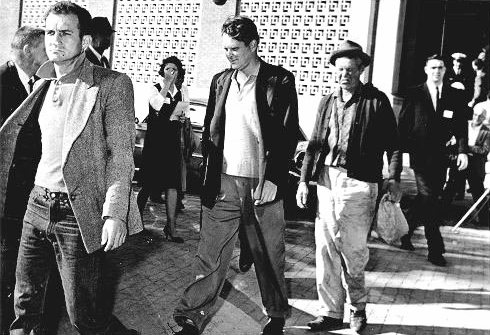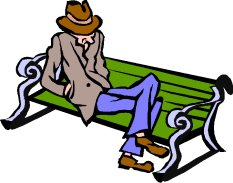

Dallas Police Sargent D.V. Harkness described how the issue began to the Warren Commission:
The tramps were marched to the Sheriff's Office via a route that led through Dealey Plaza, and in front of the Texas School Book Depository. Several news photographers shot pictures of the arrestees.Mr. HARKNESS. Well, we got a long freight that was in there, and we pulled some people off of there and took them to the station.
Mr. BELIN. You mean some transients?
Mr. HARKNESS. Tramps and hoboes.
Mr. BELIN. That were on the freight car?
Mr. HARKNESS. Yes, sir.
Mr. BELIN. Then what did you do?
Mr. HARKNESS. That was all my assignment, because they shook two long freights down that were leaving, to my knowledge, in all the area there. We had several officers working in that area.
Mr. BELIN. Do you know whether or not anyone found any suspicious people of any kind or nature down there in the railroad yard
Mr. HARKNESS. Yes, sir. We made some arrests, I put some people in.
Mr. BELIN. Were these what you call hoboes or tramps?
Mr. HARKNESS. Yes, sir.
Mr. BELIN. Were all those questioned?
Mr. HARKNESS. Yes, sir; they were taken to the station and questioned.
Mr. BELIN. Any guns of any kind found?
Mr. HARKNESS. Not to my knowledge.

So why did any of this seem sinister?
First, there was a semi-reasonable basis for suspicion. The tramps were clearly under arrest. They were taken to the Sheriff's office and questioned. But the arrest records — if there were any arrest records — had disappeared. Nobody knew whether they existed, or where they were. Nobody could find them.
Second, conspiracists started looking closely at the photos of the tramps, and becoming convinced that they could identify them. If you take all seven extant photos of the tramps, and get a lot of pictures of (say) E. Howard Hunt — and look real hard — you can become convinced that the last tramp in line (the oldest) is in fact Hunt.
Thus by the late 1970s, conspiracist "researchers" had identified at least five of the three. The first tramp in line was thought to be Thomas Vallee, or Frank Sturgis (of Watergate fame) or Daniel Carswell. The second tramp in line was identified as either Sturgis or Carswell. The last tramp was "identified" as E. Howard Hunt or Fred Chrisman.
Forensic anthropologists have the skills to go beyond merely eyeballing photos. They compare the metric and morphological characteristics of people in photos to see which match, and which don't. These are the same scientists used by the House Select Committee to confirm that the person in the Bethesda autopsy photos was in fact John Kennedy, and to debunk the notion that there are "two Oswalds" in extant photos purporting to be Lee Harvey Oswald.
The Committee's experts showed that Hunt, Sturgis, Carswell, and Vallee could not have been tramps. They could not preclude Fred Chrisman being a tramp, noting that he "strongly resembles" the third tramp. However, Committee investigators found that Chrisman had an iron-clad alibi for the day of the assassination. He was teaching high school in Oregon in 1963, and three of his fellow teachers testified that he was in school on the day of the assassination (HSCA Report, p. 92).
Other conspiracy factoids were debunked by the HSCA. For example, the notion that the tramps were "suspiciously well-dressed." The HSCA noted:
(675) All three men are shabbily dressed, befitting their apparent status as vagrants. Tramp A, however, is the better attired, wearing well-fitting jeans and a tweed-like sports jacket, although this, judged by 1963 styles, was several years out of date. Tramp B is wearing ill-fitting slacks and a double-breasted suit coat. Tramp C, from his battered fedora to his won-out shoes, has managed to achieve a sartorial effect similar to what one would expect had he been fired from a cannon through a Salvation Army thrift shop.(676) While such clothing might be a disguise, their footwear seems consistent with their classification as vagrants. All three men are shod in worn, low-cut oxfords that appear to be leather-soled. Tramp C's shoes seem to be several sizes too large for him.
 Release the Files?
Why bother?
Release the Files?
Why bother?
How did conspiracists respond to the identification of the tramps? While some accepted what the released Dallas Police files showed, many simply refused to believe the documents.
|
The conspiracists were batting zero for five.
But of course, they not only ignored the HSCA findings excluding the previously "identified" tramps, they continued to add to the roster of "suspects." Further "identifications" included:
The next big break in the case came when the Dallas City Council voted to release all city records having to do with the assassination. Journalist Mary La Fontaine, who was looking through the recently released records, happened to look at a list of records released earlier in 1989. There she found the arrest records that showed the tramps to be:
Ray and Mary LaFontaine, working for the tabloid TV program "A Current Affair," set out to find Harold Doyle, whose address was listed on the arrest record as Red Jacket, West Virginia. The trail led from West Virginia to Amarillo, Texas, where the LaFontaines found one of Doyle's former neighbors who remembered him talking about his arrest in Dallas. Doyle was finally located in Klamath Falls, Oregon. He told his story on camera (embedded video), and was also questioned by the FBI.
The FBI and private researchers sought the other two tramps. Gedney was located in Melbourne, Florida, serving as a municipal officer, a respected member of the community who had not spoken about former life as a vagabond until interviewed by researcher Billy Cox, and by the FBI. Both Doyle and Gedney told the same story of spending the night before the assassination at a rescue mission. According to Oliver Revell of the Dallas FBI office:
Both commented that they had gotten fresh clothes, showered, shaved and had a meal. They headed back to the railroad yard when they heard all the commotion and sirens and everything, and they asked what happened. They were told the president had been shot.See The Washington Post, March 4, 1992, and Dateline Dallas, Winter, 1993.
 |
Thus one of the greatest of assassination mysteries sprang from one of the most mundane Dealey Plaza realities. Three hobos swept up in the dragnet produced by the assassination were arrested and released. Suspicious of authority and fearful of being blamed, they remained quiet about their identities until the surviving two were tracked down almost 30 years later. Never objectively "mysterious" they only seemed that way because the absence of information left room for wild speculation. Thus the tramps are a metaphor for all the broader "mysteries" of the JFK murder case.